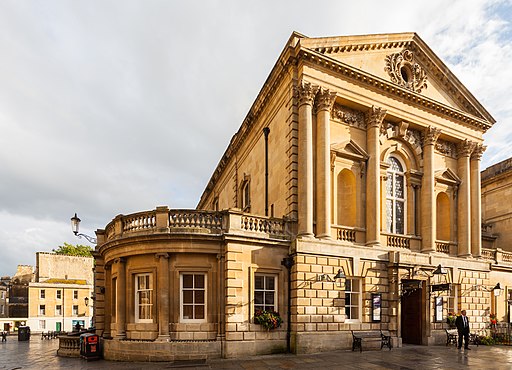It’s interesting to visit
historical places with pre-conceived notions and leave looking at things
afresh. When I visited the ancient Roman baths of Bath, England I wasn’t sure
what to expect. I went with a scene from a film adaptation of Northanger Abbey in
my mind, where the characters wore dresses, with the delicate fabric afloat
around them and drank tea while enjoying the warmth and therapeutic benefits of
the mineral baths.
 |
| Poster in the elegant lobby of the Roman baths. |
What I hadn’t considered is
that an ancient town of Aquae Sulis once thrived in the area. The mineral baths
weren’t just for healing, but also part of a temple system built for the
worship of a pagan goddess, Sulis Minerva, combining both Celtic and Roman traditions. Sulis
was a Celtic goddess of fertility and Minerva a Roman deity of healing.
 |
| One of the statues of an ancient Roman leader, added during the 19th century. |
 |
| Collection of Roman coins. |
 |
| Bronze head of Sulis Minerva statue. |
Other objects of note in the
museum are a collection of over 12,000 Roman coins, gems found caught in one of the
drains, many ancient Roman artifacts, and a large bronze head from the statue of Sulis Minerva, encased in glass.
While the coins were tossed
into the sacred spring as an offering so were sheets of lead or pewter with
curses written on them. They were often written outcries for justice against
thieves who took the clothes of those who were enjoying their time in the baths!
 |
| View of one of the baths. |
Making my way through the
museum was rather overwhelming as there was so much to take in. I saw pieces of
the temple pediment, models of the temple complex, and walked through the
enclosed building block ruins of the courtyard.
 |
| Great Bath. |
While the large pool is
still filled with the rich mineral water, visitors aren’t allowed in, but you
can sample a cup of the water. I missed out on this. If you’re especially
fortunate you may run into one of the costumed actors. I spoke with a "merchant" who had come from another country and happily shared with me about the healing
powers of urine from Portugal!
There were other rooms on the level of the bath, containing areas where once stood a cooling pool to dip into after your 115 degree soak. There was also a room once used as a sauna.
 |
| Traveling merchant with some of his wares. |
Kathleen
Rouser has loved making up stories since she was a little girl and wanted to be
a writer before she could even read. She desires to create characters who
resonate with readers and realize the need for a transforming Savior in their
everyday lives. She is a long time member in good standing of ACFW and a
former board member of its Great Lakes Chapter. Kathleen has been published in
anthologies, including the Amazon bestseller, Christmas Treasures, as well as in both print and online magazines.
Her debut full-length novel, Rumors and
Promises, was recently published by Heritage Beacon Fiction in April, 2016.
Previously a
home-school mom of three, she has more recently been a college student and a
mild-mannered dental assistant. Along with her sassy tail-less cat, she lives
in Michigan with her hero and husband of 34 years, who not only listens to her
stories, but also cooks for her.
Connect with her on the web:
Website:
kathleenrouser.com
Facebook:
facebook.com/kathleenrouser/
Twitter:
@KathleenRouser
Pinterest: https://www.pinterest.com/kerouser/




Very interesting. That water doesn't look too inviting to me....I wonder if any tourists have ever accidentally fallen into it. Thanks for sharing.
ReplyDeleteGood question, Chappydebbie! I wondered what would happen if they did. I imagine the natural water is colored by minerals. At least in the modern spa the water is clear!
DeleteKathy, this post was very informative. What an opportunity to speak to a merchant but sharing about urine in the water does not sound like a pleasant experience. The water does not look clean, but I see your remark that "the modern spa water is clear". Glad you had a great trip and experienced history.
ReplyDeleteHi Marilyn! I should clear one thing up--the merchant meant bottled urine--not sure how they
Deleteused that as a curative back then, but I don't think it went in the water. It was a wonderful
trip. Would love to do it again if I could, but I'm thankful for the blessing of at least going once.
Fascinating post! These photos are awesome! How fun it must have been to interact with the costumed actors. Thank you for sharing!
ReplyDeleteHi Caryl! Thank you. So glad you enjoyed the post and the photos. I was wishing the light
Deletewas better. It was a fun and awesome trip. I'm blessed to have a niece there in the Bath,
England area, who enjoys company!
Very interesting post, Kathy. Makes me want to go there and see that myself!
ReplyDeleteSo much history there. It was worth the time and effort to go. Thank you
Deletefor reading my post and leaving a comment, Marilyn. :)